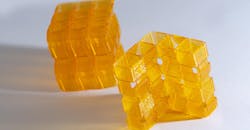Researchers Combine 3D Printing and Origami
Engineers at The Georgia Institute of Technology have merged the ancient art of folding paper, origami, with 3D printing to come up with a one-step approach to fabricating complex expandable structures. These lightweight parts could have applications in everything from biomedical devices to equipment used in space exploration. Until now, making such structures involved several steps, more than one material, and assembling smaller parts.
The researchers used a relatively new kind of 3D printing called Digital Light Processing (DLP) to create origami structures that can support significant loads and be folded and refolded repeatedly. When the team first built similar structures back in 2015, they were made of paper and required gluing. In the current work, structures are composed of a single material (a polymer) and do not require assembly.
There are many different types of 3D printing technologies; the most familiar, inkjet, has been around for some 20 years. But until now, it has been difficult to create 3D-printed structures with intricate hollow features such as those associated with complex origami. That’s because removing the supporting materials necessary to print these structures is challenging. Further, unlike paper, 3D-printed materials could not be folded over and over without breaking.
The key to the new structures are the properties inherent in DLP. Unlike other 3D printing techniques, it builds objects by printing successive layers of a liquid resin that is then cured, or hardened, by ultraviolet light. For the current work, the researchers developed a new DLP resin that is strong when cured.
The resin, in turn, is key to an important element of the work structure: tiny hinges. These hinges, which are placed along the creases where the structure folds, can fold because they consist of a thinner layer of resin than the rest of the structure’s larger panels. The panels make up the bulk of the structure.
The team has used DLP to create several origami structures ranging from individual origami cells to a complex bridge composed of many blocks. All were subjected to tests that showed they could be carrying about 100 times the weight of the origami structure and be repeatedly folded and unfolded without breaking.

